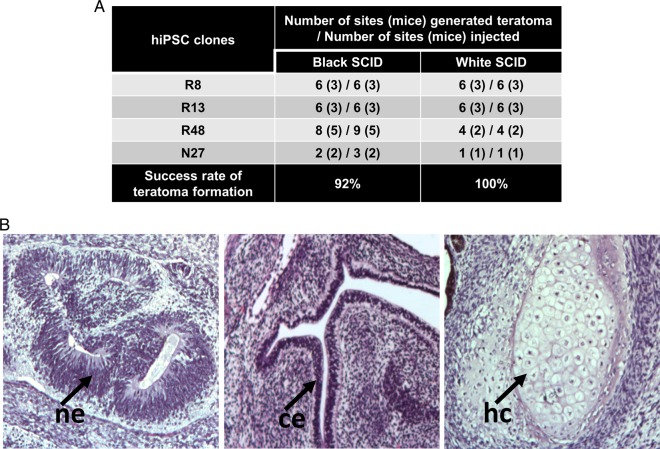- You are here: Home
- Services
- Stem Cell Research
- iPSC Characterization
Services
-
Cell Services
- Cell Line Authentication
- Cell Surface Marker Validation Service
-
Cell Line Testing and Assays
- Toxicology Assay
- Drug-Resistant Cell Models
- Cell Viability Assays
- Cell Proliferation Assays
- Cell Migration Assays
- Soft Agar Colony Formation Assay Service
- SRB Assay
- Cell Apoptosis Assays
- Cell Cycle Assays
- Cell Angiogenesis Assays
- DNA/RNA Extraction
- Custom Cell & Tissue Lysate Service
- Cellular Phosphorylation Assays
- Stability Testing
- Sterility Testing
- Endotoxin Detection and Removal
- Phagocytosis Assays
- Cell-Based Screening and Profiling Services
- 3D-Based Services
- Custom Cell Services
- Cell-based LNP Evaluation
-
Stem Cell Research
- iPSC Generation
- iPSC Characterization
-
iPSC Differentiation
- Neural Stem Cells Differentiation Service from iPSC
- Astrocyte Differentiation Service from iPSC
- Retinal Pigment Epithelium (RPE) Differentiation Service from iPSC
- Cardiomyocyte Differentiation Service from iPSC
- T Cell, NK Cell Differentiation Service from iPSC
- Hepatocyte Differentiation Service from iPSC
- Beta Cell Differentiation Service from iPSC
- Brain Organoid Differentiation Service from iPSC
- Cardiac Organoid Differentiation Service from iPSC
- Kidney Organoid Differentiation Service from iPSC
- GABAnergic Neuron Differentiation Service from iPSC
- Undifferentiated iPSC Detection
- iPSC Gene Editing
- iPSC Expanding Service
- MSC Services
- Stem Cell Assay Development and Screening
- Cell Immortalization
-
ISH/FISH Services
- In Situ Hybridization (ISH) & RNAscope Service
- Fluorescent In Situ Hybridization
- FISH Probe Design, Synthesis and Testing Service
-
FISH Applications
- Multicolor FISH (M-FISH) Analysis
- Chromosome Analysis of ES and iPS Cells
- RNA FISH in Plant Service
- Mouse Model and PDX Analysis (FISH)
- Cell Transplantation Analysis (FISH)
- In Situ Detection of CAR-T Cells & Oncolytic Viruses
- CAR-T/CAR-NK Target Assessment Service (ISH)
- ImmunoFISH Analysis (FISH+IHC)
- Splice Variant Analysis (FISH)
- Telomere Length Analysis (Q-FISH)
- Telomere Length Analysis (qPCR assay)
- FISH Analysis of Microorganisms
- Neoplasms FISH Analysis
- CARD-FISH for Environmental Microorganisms (FISH)
- FISH Quality Control Services
- QuantiGene Plex Assay
- Circulating Tumor Cell (CTC) FISH
- mtRNA Analysis (FISH)
- In Situ Detection of Chemokines/Cytokines
- In Situ Detection of Virus
- Transgene Mapping (FISH)
- Transgene Mapping (Locus Amplification & Sequencing)
- Stable Cell Line Genetic Stability Testing
- Genetic Stability Testing (Locus Amplification & Sequencing + ddPCR)
- Clonality Analysis Service (FISH)
- Karyotyping (G-banded) Service
- Animal Chromosome Analysis (G-banded) Service
- I-FISH Service
- AAV Biodistribution Analysis (RNA ISH)
- Molecular Karyotyping (aCGH)
- Droplet Digital PCR (ddPCR) Service
- Digital ISH Image Quantification and Statistical Analysis
- SCE (Sister Chromatid Exchange) Analysis
- Biosample Services
- Histology Services
- Exosome Research Services
- In Vitro DMPK Services
-
In Vivo DMPK Services
- Pharmacokinetic and Toxicokinetic
- PK/PD Biomarker Analysis
- Bioavailability and Bioequivalence
- Bioanalytical Package
- Metabolite Profiling and Identification
- In Vivo Toxicity Study
- Mass Balance, Excretion and Expired Air Collection
- Administration Routes and Biofluid Sampling
- Quantitative Tissue Distribution
- Target Tissue Exposure
- In Vivo Blood-Brain-Barrier Assay
- Drug Toxicity Services
iPSC Characterization
iPSC generation has become increasingly easier because of advanced technology, but the characteristics of various iPSCs is depending on the source, derivation, passage and culture conditions. In order to evaluate the pluripotency, safety and confirm the identity of PSCs, it is essential to perform a set of characterization analysis. Our scientists with extensive experience at Creative Bioarray provide comprehensive iPSC characterization service for customers all over the world.
Creative Bioarray Offers iPSC Characterization Service as Follows (including but not limited to):
1. Pluripotency and lineage-specific markers staining:
- Alkaline phosphatase live staining
- Immunocytochemistry for key pluripotency markers
- qPCR and RNA-seq
- TaqMan hiPSC scorecard assay
2. Karyotyping:
- Comparative genomic hybridization analysis
- G-banding
- Multicolor FISH (M-FISH) analysis
- Chromosomal microarray analysis
- q-PCR analysis
3. Differentiation potential analysis:
- Potential of directed differentiation into specific lineages
- Embryoid body (EB) formation
- Teratoma formation assay
4. Microbiological contamination testing:
5. Genome sequencing analysis:
- Whole genome sequencing
- Exome gene sequencing
- cDNA expression analysis
6. HLA typing for potential transplantation studies
7. DNA Fingerprinting (Short tandem repeats (STR) profiling)
Example of Teratoma Formation Assay Results:

Creative Bioarray is an experienced and outstanding provider of iPSC characterization services. We are dedicated to providing detailed data and comprehensive service for your scientific research, and we are pleased to use our extensive experience and advanced platform to offer the best service to satisfy each demand from our customers.
If you have any special need in iPSCs characterization, do not hesitate to contact us for this special service. Please let us know what you need and we will accommodate you. We are looking forward to working with you in the future.
References
- Steichen, et al. "Messenger RNA‐versus retrovirus‐based induced pluripotent stem cell reprogramming strategies: Analysis of genomic integrity." Stem cells translational medicine 3.6 (2014): 686-691.
- Baghbaderani, et al. "Detailed characterization of human induced pluripotent stem cells manufactured for therapeutic applications." Stem Cell Reviews and Reports 12.4 (2016): 394-420.
Explore Other Options
For research use only. Not for any other purpose.

